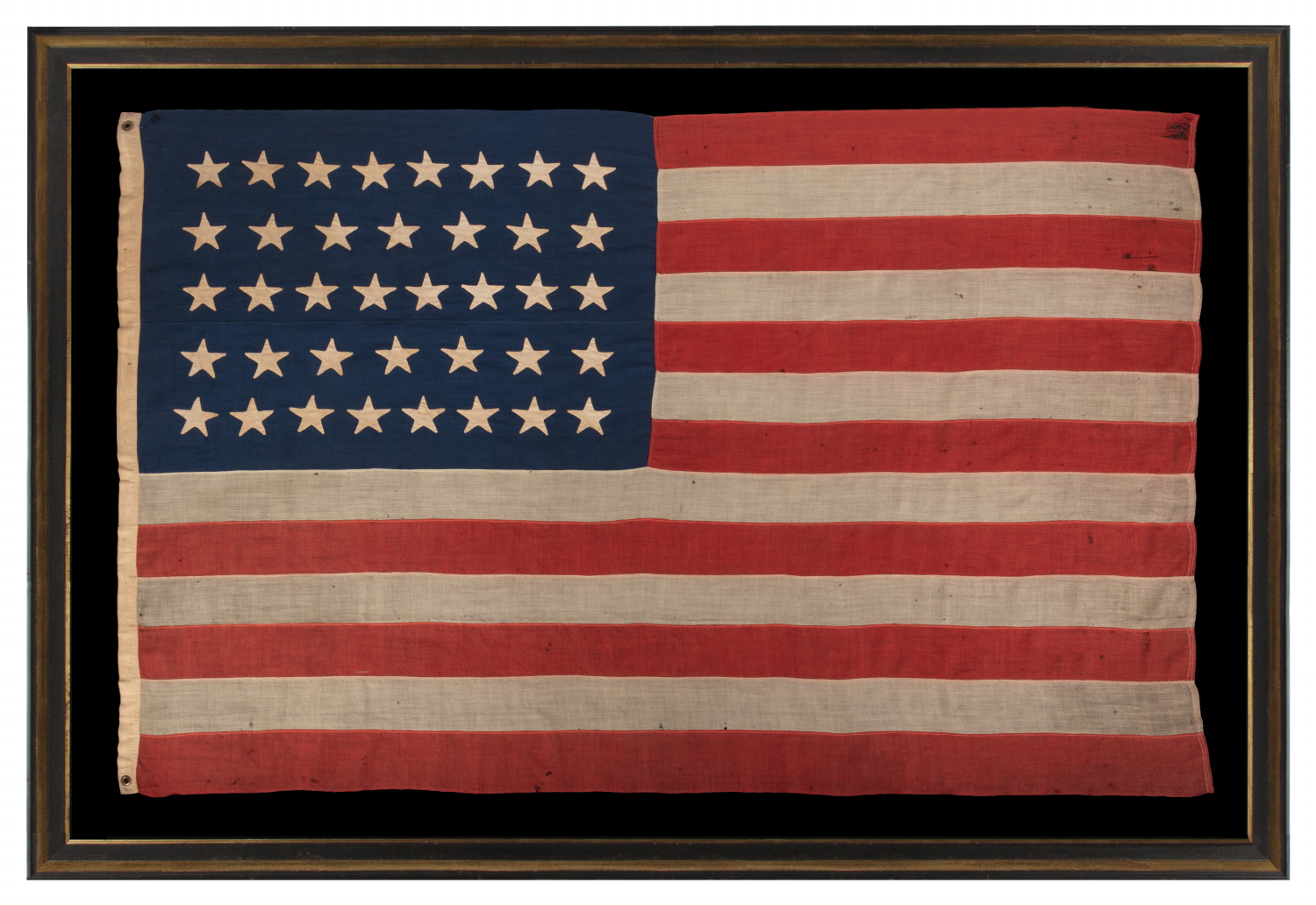
| |
38 STAR ANTIQUE AMERICAN FLAG WITH HAND-SEWN STARS IN AN 8-7-8-7-8 PATTERN OF JUSTIFIED ROWS, MADE IN THE PERIOD WHEN COLORADO WAS THE MOST RECENT STATE TO JOIN THE UNION, 1876-1889 |
|
| Available: |
Sold |
| Frame Size (H x L): |
Approx. 70" x 101" |
| Flag Size (H x L): |
58" x 89" |
|
| Description....: |
|
38 star American national flag, with pencil-inscribed names of a child and his uncle, who resided together at one point near Lake Erie, west of Cleveland, Ohio. The stars of the flag are made of cotton, hand-sewn, and double-appliquéd (applied to both sides) of the blue canton. These are arranged in justified lineal rows in counts of 8-7-8-7-8, which is a traditional format for the 38 star count, and all of the stars are oriented in an upright position on their vertical axis (i.e., with one point up). The stripes and canton of the flag are made of wool bunting that has been pieced with treadle stitching, typical of the period. Because wool bunting was only available in a maximum width of eighteen inches, the canton is constructed from two lengths of blue fabric. There is a twill cotton binding along the hoist, with two brass grommets.
Colorado became the 38th state on August 1st, 1876. This was the year of our nation’s 100-year anniversary of independence. Per the Third Flag Act of 1818, stars were not officially added until the 4th of July following a state's addition. For this reason, 37 was the official star count for the American flag in 1876. Flag-making was a competitive venture, however, and few flag-makers would have been continuing to produce 37 star flags when their competitors were making 38’s. It is for this reason that 38 and 13 stars (to represent the original 13 colonies) are more often seen at the Centennial International Exposition, the six-month long World’s Fair held in Philadelphia in honor of the event. Some flag-makers would have been adding a star for the 38th state even before it entered the Union, in the early part of 1876 or even prior. In fact, many makers of parade flags were actually producing 39 star flags, in hopeful anticipation of the addition of two more Western Territories instead of one. But the 39th state would not join the Union for another 13 years, when the Dakota Territory entered as two states (numbers 39 and 40) on the same day, November 2nd, 1889.
On the reverse of the binding there are three penciled inscriptions, "Dawson," "Taggart," and "Bill Ryals." Although separated, the first two names actually go together, although the connection is not as one might expect.
William (Bill) J. Ryals (b. 12/20/1928) was 11 years old and enrolled at school in the 4th grade when he appears on the 1940 census record, living with parents Corning D. Ryals (1896-1965) and Janet T. Ryals (1894-1957). The "T" in Janet's name almost certainly stood for "Taggart," as her given name on her Marriage certificate was Mary J. Taggart.
Also residing in the Ryals household in 1940 was her brother, Bill's uncle, Jackson Dawson Taggart (06/23/1897 - 09/29/1944), who went by "J. Dawson" and, occasionally, by "Dawson J." The Ryals family owned a flower shop and, in 1940, J. Dawson Taggart was a floral industry wholesaler. One could easily presume that J. Dawson Taggart was likely the original owner of the flag. He died during WWII, in 1944 (though not in military service, as near as I can tell), and apparently handed it down to his nephew. This may have taken place prior to 1940, of course, but seems more likely to have occurred sometime between that year and his death in 1944. The name "Taggart" appears to been added over top of a forth name, now illegible. I spent many hours researching how the Taggart family may have came into possession of the flag, running down what seemed to be every possible lead, but this information remains unknown.
Mounting: The flag was mounted and framed within our own conservation department, which is led by expert staff. We take great care in the mounting and preservation of flags and have framed thousands of examples.
The background is 100% cotton twill, black in color. The black-painted, hand-gilded and distressed molding is Italian. The glazing is U.V. protective plexiglas.
Condition: The flag was certainly flown, evidenced by the wear with associated loss in the upper hoist and fly-end corners. There is minor oxidation of the white fabrics and there are a few tiny stains on the hoist binding. There is extremely minor mothing. Many of my clients prefer early flags to show their age and history of use. |
|
|
|
| Collector Level: |
Intermediate-Level Collectors and Special Gifts |
|
| Flag Type: |
Sewn flag |
|
| Star Count: |
38 |
|
| Earliest Date of Origin: |
1876 |
|
| Latest Date of Origin: |
1889 |
|
| State/Affiliation: |
Colorado |
|
| War Association: |
1866-1890 Indian Wars |
|
| Price: |
SOLD |
|
| |
Views: 1282 |
|
|
|

